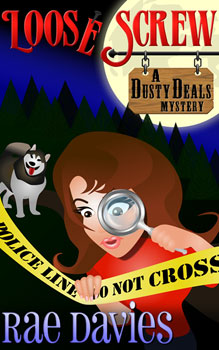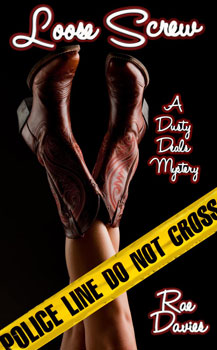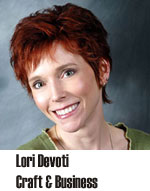A year ago I decided to start self-publishing. It was a slow start, but like many other self-pubbed authors, the holiday season (December 2010 and January 2011) were very kind to me.
I was excited.
I told my writer friends.
Some shared my enthusiasm some didn’t. Many who weren’t previously published by New York poo pooed my success as something they couldn’t attain because they didn’t have a “name” otherwise known by marketing gurus as a “platform.” Please note the scare quotes there. I use them because while I do have fans, I am not a “name” and really believed the success I’d had was more from Amazon algorithms than my fans searching out my stuff.
But I heard that a lot.
So I decided to do a bit of an experiment. I took on the job of revising the very first manuscript I’d ever written, an amateur sleuth mystery titled Loose Screw.
The book needed work–lots of it. But I put in that work and in March put the book out under a pen name.
I created the cover myself with my target market in mind. First, though, I had to decide who that target market was. I had a few choices. One was people who buy dog mysteries. Loose Screw features the main character’s Alaskan malamute, Kiska.
I love that dog and he was really important to me so a logical direction to go.
Another option was people who like antiques mysteries. Lucy, the main character, owns an antique shop and for a major part of my life, I’ve been involved with antiques. I love antiques. So, again, a logical choice.
Then there is Montana where the book is set and a state I also love.
All of these things were important to me and the book and, like many authors, my first instinct was to put them all on the cover.
That cover looked…yawn. Dull and dry. Yes it was factual, but to steal an advertising saying, I was selling the steak instead of the sizzle.
My degree is in advertising. I managed an advertising department at a daily newspaper. I love advertising. I know advertising. And I was completely guilty of ignoring all of that and selling the damn steak.
That cover never made it online.
Back to the drawing board, or, in this case, Amazon I went. I looked at books that were selling and immediately realized my mistake.
First, dog mystery lovers, antiques mystery lovers and Montana lovers might be my market, but the weren’t the biggest market. The biggest market was lovers of fun mysteries with a chick lit tone.
I had that–but my cover SO didn’t say that.
I dumped the dog, dumped the antique store background and dumped the lovely drop of blood that I had hoped said “mystery.”
I came up with this…
Not the best thing ever designed. (I am NOT a graphic artist.) But it gave the feel I wanted. I put my book up and waited.
I did a little promotion. I mentioned it on my blog as part of a general promotion I was doing–but didn’t say I wrote the book. I mentioned other people’s books too.
I gave away five copies along with another mystery that was selling pretty well to give my “also boughts” a bit of a boost.
And that was about it.
Amazon U.S. Sales Only
March: 7
April: 5 (Then because I wanted this to be the first book in a series and wanted to pull in as many readers for those future books as I could, I lowered my price to $.99–this is probably the most important thing I did.)
Rest of April at $.99: 11
May: 145
June: 515
July: 1,318
August: 1,753
September: 1,740
At this point, Loose Screw’s ranking had gotten as low as #750 or so, but bounced back up to #1,800. I felt I was losing ground and needed to give things a boost. I also knew my cover looked exactly like what it was–something someone who wasn’t an artist had put together with Photoshop.
 I hired India Drummond to do a new cover for me. I got that up at the end of September. My ranking dropped immediately back down to #1,000 and continued to drop. The past few days the book has been at a low of #550 and a high of around #650. Average sales a day have jumped too.
I hired India Drummond to do a new cover for me. I got that up at the end of September. My ranking dropped immediately back down to #1,000 and continued to drop. The past few days the book has been at a low of #550 and a high of around #650. Average sales a day have jumped too.
October through the 11th: 885
Now, before anyone says it–yes, this book is $.99. No, I am not getting rich here. But I have made as much as many people who sell to NY get for their first books in an advance–and the book is still selling.
And more important to me, I am building an audience for the next book that I plan to start writing next month.
I also proved my point (which since I do love to be right is VERY important) that you do not have to have a “name” or a “platform” to sell self-published books.
You do, though, have to:
1.) Know your audience
2.) Target that audience with a cover and product description that grabs them
3.) Have a book that then meets their expectations
And that is it.
Simple as 1,2, 3.
Now I just need to find the time to relook at all of my books and see where I may have missed my market. How about you?



Love your story, love the way you tell it, and yes, book covers are very important! What is interesting here is that you didn’t change your price through this experiment: 99 cents throughtout. That PROVES that the difference comes from the cover. Well done!
Of course someone with a background in advertisement like you had to know that what’s needed is the sizzle and not the steak and you found a good book cover designer with a bit of humor in her drawings. That’s great and you probably should keepusing her (and that style) for all your books in that series. That’s what brand building is all about, isn’t it?
Because in the end, a book cover is also …a brand. I think that’s what people don’t always understand. They go for “pretty” or cute things rather than a brand that hits you on the head!
At least that’s what I hope I understood about book covers – and btw, books covers that are digital are VERY different from those on printed books that can afford to be more complex. A digital book cover also has to work in tiny size and greyscale (on the Kindle). That means an even greater focus on simplicity and sizzle!
If you have a minute, check my book covers and let me know what you think! I’d love to have your opinion!
Thanks for sharing your story, I love the behind-the-scenes tales being an author. Your book cover always catches my eye on KB so it is pretty effective! Wishing you all success with future series! :)
Thanks, Claude and Fatima. :)
Claude, on your covers, I think they are really nice and you definitely have the “look” going to show they are related. Are you selling the sizzle? I don’t know because I haven’t researched your market and what sells other books in your market. Just looking at your covers, I would think your book was mainstream fiction, maybe historical. It could have a mystery element, but it doesn’t scream that at me.
Does that help?
Thanks for letting us have a look at the process! Great post!
As a reader, I consider the over extremely important. It is the first thing I see when browsing for books on Amazon. If the cover looks like something that is not in my preferred genres, I am likely to not even open the book’s page. If I have opened the page and the cover looks like a total piece of amateur work, I am not likely to scroll down to read the description.
My time is precious to me. If the author does not care to put effort into the cover, how do I know there is effort in the books?
Thanks for sharing your story about the cover and your sales figures. The story was very interesting, but the sales figures really bring the point home.Know your audience and make sure the cover appeals that audience.
Great tips, Lori! I think you’re SO right about carefully targeting your audience with every cover, especially if the genre isn’t 100% clear from the title. Ebook readers make decisions in seconds, and the title + cover needs to create an irresistible first impression.
Thanks for sharing “real-time” numbers, too. I think we NY-pubbed authors have been programmed to expect big sales right out of the gate, but e-publishing is more about the slow build and the “long tail.” Congrats on the success of your new series!
Great information, Lori. Thanks for sharing. This will go perfectly with the workshop I’m doing for NINC on ebook packaging.
Loved what you said, and have put it on twitter.
Stella
Thanks, everyone!
Thank You this was awesome! I am going to seriously recommend this to as many of my writer/author friends as possible. (Now I have to go buy the book!)
Thanks Lori for the insight
Great post, Lori! Every article I read from the self-proclaimed “publishing professionals” states as fact that the only authors who are successful self-publishing are those who were already a “name brand” and spend half their day on twitter, facebook, etc. They refuse to believe that it really is about a good cover, a good description, and a good book. Kudos to you for proving them wrong.
Thanks, Lori.
I wish publishers used the same logic!
I’ve changed covers on my Indie books too hoping to see
a good result. So far, I’d say I need to change them again.
A good point to keep in mind. Never thought a cover could have that much impact on sales. Shows what I know. ;-)